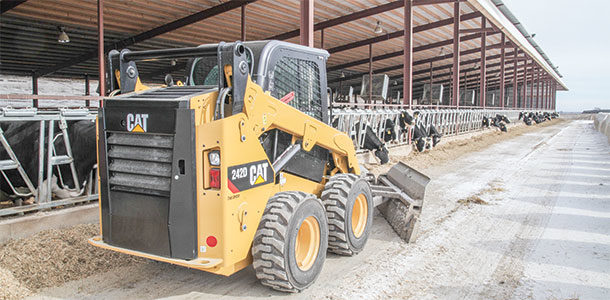Regular machine maintenance is important for safety, efficiency and productivity. Practicing due diligence can also save money over the long term, as the cost of downtime can far outweigh standard maintenance expenses.
As with any major purchase, costs to consider go beyond the initial price tag. Machinery should be thought of as an investment in your business, and maintenance costs are necessary to ensure a long life cycle. Investing in maintenance now can keep replacement-part expenses in check and extend the life of the machine.
Preventative maintenance
Now that you’ve found the most maintenance-friendly skid-steer loader for your operation, keeping it in prime condition is critical. Regular testing, cleaning and keeping up with suggested maintenance intervals for your specific machine are vital to its preservation.
Proper upkeep will result in a durable machine that burns less fuel and is easy for an operator to use – factors that lead to maximum productivity.
The old adage, “If it ain’t broke, don’t fix it” does not apply here. Normal wear and tear can cause damage to your machine that may go undetected during everyday use.
But advance warning about a potential issue could eliminate premium costs associated with unscheduled maintenance if the issue is left unnoticed. You don’t want to have to call the dealer for costly field maintenance, or worse, take the machine offline altogether for repairs.
Due to its physical location, a skid-steer loader undercarriage can be especially susceptible to deterioration. Left unattended, it can also be one of the most expensive parts to repair. Therefore, careful attention to routine maintenance is important for longevity.
Simply practicing good operator techniques will increase undercarriage life cycles. In general, sharp turns, counter-rotations, constant side-sloping and high-speed reverse all greatly increase undercarriage wear and should be avoided whenever possible.
Walk-around inspections should be performed daily on the entire machine before getting into it. The following checklist will help. Don’t take any shortcuts with these important fundamentals.
- Check the oil and coolant levels, adding more if needed.
- Examine the fuel-water separator and drain water if necessary, disposing of it properly according to local regulations.
- Inspect tires and tire pressure on both sides; look for cuts and make sure lug nuts are tight.
- Check for electrical line or hydraulic line damage and leaks.
- Look for structural problems, cracks or general damage to the machine.
- Check work tool for anything out of the ordinary.
- Remove any debris that may have fallen between the lift arm and work tool.
-
Check hydraulic oil and fuel levels.
- Grease all fittings at recommended intervals; use the maintenance manual provided by the OEM to find their locations and be sure not to miss any.
Running an efficient operation gives your business a competitive advantage, and working machinery is essential to success. But beyond that, you need to get the most of your skid-steer loader at all times to reduce operating costs and make the most of productivity.
Maintenance should be top of mind when considering the purchase of a new machine. Making it part of your daily routine will allow you to work faster and more efficiently than ever, getting every possible minute of production out of your skid-steer loader. FG
Jeff Brown is the product specialist at Caterpillar Inc.












